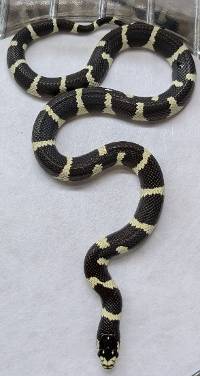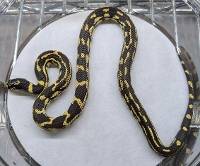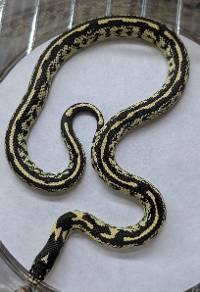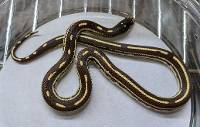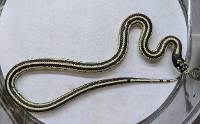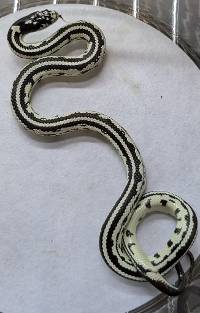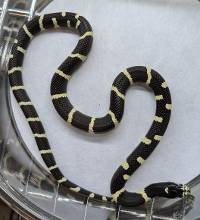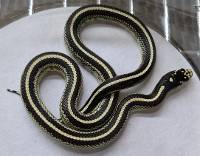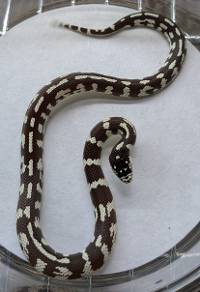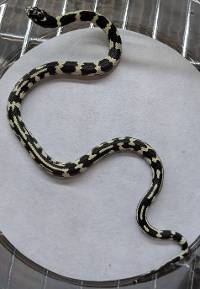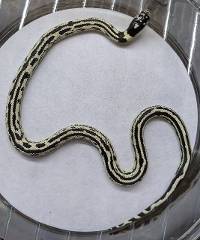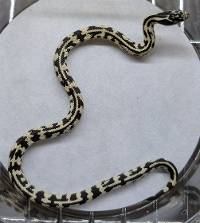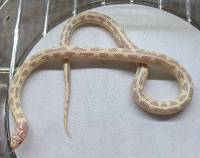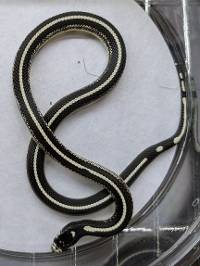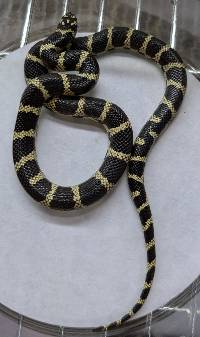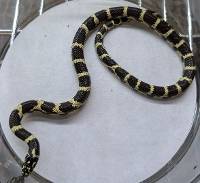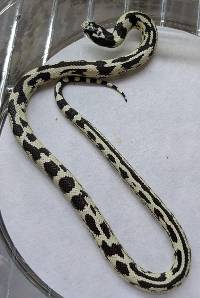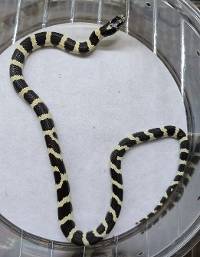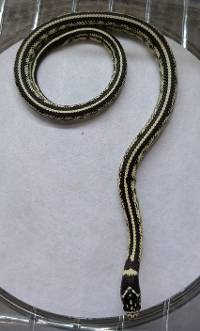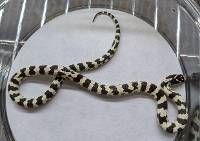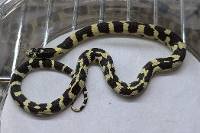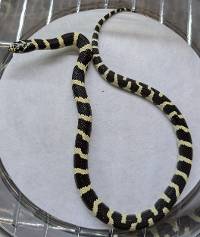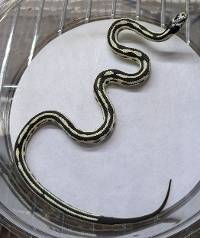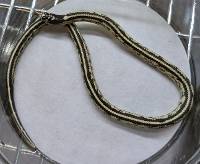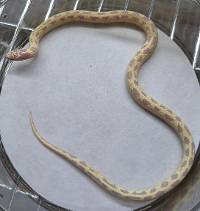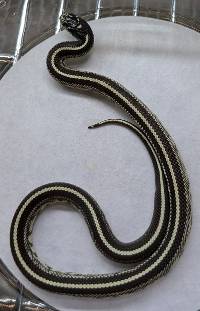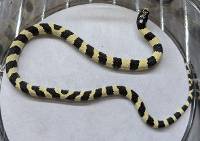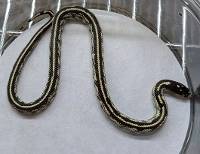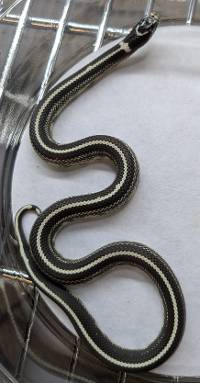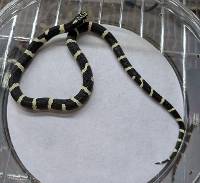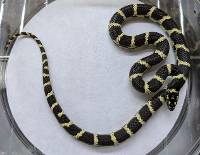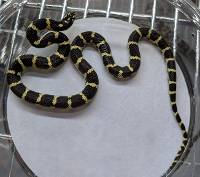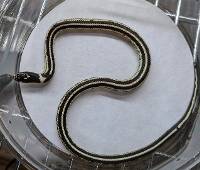Josh's Frogs
Why you should buy from us
California Kingsnakes - Lampropeltis getula californiae (Individually Pictured) - Black/white Stripe CKS-070824
California Kingsnakes - Lampropeltis getula californiae (Individually Pictured) - Black/white Stripe CKS-070824
Sex: Female
About This Product
The snake pictured is the EXACT animal for sale!
Defining Characteristics:
- Distinctive, attractive appearance
- Docile temperaments
- One of the most popular pet snakes in the US
Name: Lampropeltis getula califoniae, California Kingsnake, Kingsnakes earned their name because they prey on and eat other snakes.
Recommended Enclosure Size & Setup: The guideline for enclosure size for kingsnakes is snake length x half snake length = enclosure length and width (footprint). As such, a single adult California Kingsnake should be kept in a 4’x2’x2’ front-opening enclosure at minimum, but bigger is better as they are active snakes and love to explore. Kingsnakes are not social animals and should be housed individually, especially since they are known snake-eaters.
A semi-arid bioactive setup is strongly recommended for this species. A mixture of about 60% topsoil (such as Zoo Med ReptiSoil) and 40% sand (such as Exo Terra Desert Sand) works well to closely mimic their natural habitat, while mixing in sphagnum moss, cypress, and leaf litter will help provide nutrients that plants and microfauna need to thrive. Substrate should be 4-6 inches deep. Isopods (such as dwarf whites and powder oranges) springtails, and live desert plants can be used to create a beautiful bioactive arid enclosure!
California Kingsnakes are intelligent, versatile, and active animals, so various types of décor and enrichment should be provided to stimulate their natural instincts. Cork flats, live desert plants, and leaf litter work well as hides and will help your snake feel safe and secure. Climbing materials like manzanita wood and driftwood will encourage your snake to climb and explore as well as promote their overall health and well being. Any climbing materials should be supported by the bottom of the enclosure instead of the substrate.
Check out our Kingsnake habitat kits!
Temperature (°F) & Lighting: Because kingsnakes are reptiles, they need a range of temperatures within their enclosure so they can regulate their own body temperature as needed. Areas of heat speed up their metabolism and promote activities like digestion and healing. Cool areas slow the metabolism and promote activities like rest and energy conservation.
California Kingsnakes should be kept at ambient temperatures of 70-80°. A basking spot of 85-90° should be maintained during the day. This can be created by placing a piece of slate/stone or a branch below the heat lamps. Using an overhead heat source such as the Zoo Med Repti Tuff Splashproof Halogen Lamp used in conjunction with the Zoo Med Deep Dome Lamp Fixture works well to mimic the sun. Two heat bulbs should be enough to create a large enough basking area for your kingsnake. Heat rocks should not be used as they run the risk of burning your snake. Ambient temperatures should be monitored with two digital thermometers placed on either end of the enclosure, and the basking spot should be monitored with an infrared temperature monitor. Heat sources should be turned off at night to facilitate natural nighttime temperature drops and benefit your snake’s overall health and well being.
UVB lighting is strongly recommended. California Kingsnakes are diurnal and require UV exposure to stimulate activity and natural behaviors, and they will also use the UVA wavelengths visible to all reptiles to properly inform basking behavior and circadian rhythm. UV lighting should be focused on their basking site and feature Ferguson Zone 2 levels of UV radiation. Animals should also be provided opportunities to escape from UV exposure throughout the rest of their enclosure.
Humidity: California kingsnakes are a semi-arid species and ambient humidity should be kept at 40-60%, which can be monitored with a digital hygrometer. This species should be misted once a day with the goal of providing droplets of water on the walls of the enclosure from which the snake may drink as well as maintaining proper moisture levels in the substrate.
Although Cal Kings can survive dry conditions, they still need access to humid microclimates in order to stay hydrated, keep their lungs healthy, and shed their skin properly. To be specific, they should have access to a humid hideout at all times. This hide should be placed on the cool half of the enclosure and lined with moistened sphagnum moss or substrate. They should also always have access to a bowl of fresh, clean water that is large enough for them to coil up and soak in.
Size: California Kingsnakes hatch at around 8-12 inches. While the maximum size for a Cal King is more than six feet in length, the average size is about 3-4 feet long. California Kingsnakes are a more slender species, so they seem smaller than they actually are.
These animals are around 1-1.5 feet at the time of sale.
Age: California Kingsnakes can live 20+ years in captivity if provided with quality husbandry.
Feeding: Kingsnakes are obligate carnivores, which means they need a diet of whole animal prey to get the nutrition that their bodies need. Juveniles should be fed every 7-10 days, and adults should be fed every 10-14 days. The size of your snake’s prey should be no more than 1.5 times the width of your kingsnake at its widest point, or roughly 10% of its body weight. If the snake seems to be getting fat, reduce the frequency of feedings or the size of the feeders.
Always feed your snake inside its enclosure, not outside. Contrary to the myth, feeding inside does not make snakes more aggressive. However, use feeding tongs to offer the prey, not your hand, in order to prevent accidental strikes.
Kingsnakes are opportunistic feeders, so variety is essential to complete nutrition. Prey items for Kingsnakes include mice, young rats, hamsters, gerbils, quail hatchlings and quail eggs, chicks, reptile eggs, green anoles, and house geckos. If you have the opportunity to offer your king snake an appropriately-sized, captive-bred snake as a feeder, do it! However, do not offer live prey if it can be avoided. Frozen feeders should be completely thawed to 75-100°F before offering.
Sexing: Males have longer and thicker tails than females
Color/Pattern: California Kingsnakes are known for their distinctive, attractive appearance: oval head, round pupils, slender body, and smooth, glossy scales. They are typically colored in broad, alternating bands of black and white or brown and yellow/cream, but other patterns are known to occur.
Social Behavior: Kingsnakes are not social animals and they are known to be ophiophagus (snake-eaters), so it is highly recommended to only house one snake per enclosure.
California Kingsnakes are some of the most popular pet snakes in the United States, and generally tolerate human interaction well, which makes them good pets for people who are new to snakes. It is recommended to wait at least two weeks before trying to handle your new snake.
Once your kingsnake is ready for handling, take it slow at first. Start with brief handling sessions (no longer than 5 minutes), and don’t return the snake until it is calm. This teaches your snake how to behave during handling by using rudimentary positive reinforcement. Once this has been accomplished, you can work up to longer sessions. Handling should occur at least weekly, but no more than once daily. While handling your snake, be gentle. Rather than grabbing it, let it crawl onto your hand. Lift it from below rather than above, and support as much of its body as possible. Use slow movements and don’t walk around too much.
They are a diurnal and particularly active species, so they make wonderful display animals as well.
Breeding: The California kingsnake is an oviparous internal fertilization animal, meaning it lays eggs, as opposed to giving live birth like some other snakes. Breeding season for Cal Kings begins in the spring, usually sometime after their hibernation or first shedding. Eggs are laid between May and August, which is generally 42–63 days after mating. The typical clutch size is 5 to 12 eggs, and hatchlings usually emerge another 40–65 days later.
Natural Range: California kingsnakes are found primarily on the southwestern coast of the United States and the northwestern tip of Mexico, including the Baja Peninsula. In the wild they can be found in a variety of habitats, including forests, grassland, scrub, and desert.
History in the Hobby: California kingsnakes are some of the most popular pet snakes in the US due to their docile temperaments, hardiness, and attractive coloring.
Links of Interest:
Shipping
After placing an order containing a live animal, you will receive a scheduling email containing our JotForm scheduling link to schedule your new pet's delivery date.
With this scheduling link, you will be able to schedule your order's delivery up to 30 days in advance. You will be able to choose a date of delivery for Tuesday-Saturday (Saturday arrival depends on the carrier's service availability) with the estimated time of arrival generally being 12pm, or 4:30pm for more rural areas. Overnight lows must be above 40°F to ship directly to you (or above 30°F for FedEx Ship Center/UPS Customer Center pickups) as well as below 90°F by estimated time of arrival.
If you require further assistance, or prefer to talk to one of our Customer Service agents, please feel free to reach out to our [email protected] email or our phone line 1-800-691-8178.
Customer Reviews
Review data
5 star reviews
- 0%
4 star reviews
- 0%
3 star reviews
- 0%
2 star reviews
- 0%
1 star reviews
- 0%


